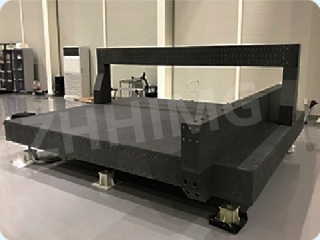Granite base is commonly used in semiconductor equipment due to its excellent vibration dampening properties, thermal stability, and low coefficient of thermal expansion. However, like any other material, granites can develop faults that can affect the performance of semiconductor equipment. In this article, we'll highlight some of the common faults of granite base in semiconductor equipment and provide solutions.
Fault #1: Surface Deformations
Surface deformations are the most common faults in granite base in semiconductor equipment. When the granite base is subjected to temperature changes or heavy loads, it can develop surface deformations, such as warps, twists, and bumps. These deformations can interfere with the alignment and accuracy of semiconductor equipment.
Solution: Surface Corrections
Surface corrections can help alleviate surface deformations in granite base. The correction process involves re-grinding the surface of the granite base to restore its flatness and smoothness. Keen attention should be paid to selecting the right grinding tool and the abrasive used to ensure that precision is maintained.
Fault #2: Cracks
Cracks can develop in granite base as a result of thermal cycling, heavy loads, and machining errors. These cracks can lead to structural instability and significantly affect the precision of semiconductor equipment.
Solution: Filling and Repairing
Filling and repairing cracks can help restore the stability and precision of granite base. The repair process typically involves filling the crack with an epoxy resin, which is then cured to restore the strength of the granite surface. The bonded surface is then re-ground to restore flatness and smoothness.
Fault #3: Delamination
Delamination is when layers of the granite base separate from each other, creating visible gaps, air pockets, and inconsistencies in the surface. This can arise from improper bonding, thermal cycling, and machining errors.
Solution: Bonding and Repairing
The bonding and repair process involve the use of epoxy or polymer resins to bond the delaminated granite sections. After bonding the granite sections, the repaired surface is then re-ground to restore flatness and smoothness. The bonded granite has to be checked for any remaining gaps and air pockets to ensure that the granite base is fully restored to its original structural strength.
Fault #4: Discoloration and Staining
Sometimes the granite base can develop discoloration and staining issues, such as brown and yellow spots, efflorescence, and dark stains. This can be caused by chemical spills and inadequate cleaning practices.
Solution: Cleaning and Maintenance
Regular and proper cleaning of the granite base can prevent discoloration and staining. The use of neutral or mild pH cleaners is recommended. The cleaning process should follow the manufacturer's instructions to avoid damaging the granite surface. In case of stubborn stains, a specialized granite cleaner can be used.
In summary, granite base is a durable and reliable material that is widely used in semiconductor equipment. However, it may develop faults over time due to temperature changes, heavy loads, and machining errors. With proper maintenance, cleaning, and repair, granite base can be restored, ensuring optimal performance of semiconductor equipment.
Post time: Mar-25-2024

